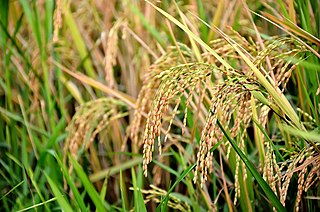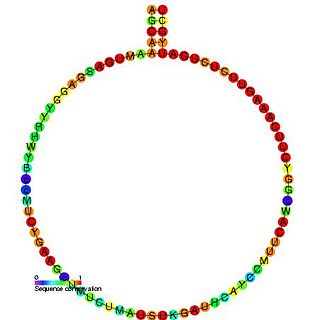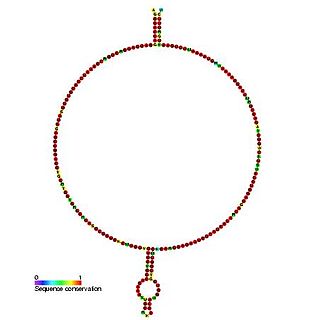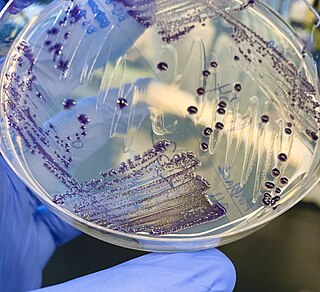Hydroxycinnamic acids
| | This section is empty. You can help by adding to it. (December 2015) |
Oryza is a genus in the plant family Poaceae, of which Oryza sativa (cultivated rice) is a member. Oryza is a genus of 24 species, most of which are annual and some perennial grasses, which are found in tropical and swampy parts of Africa, Asia and Australia. Given its wide geographic range, there exists a substantial diversity of specialized metabolites (also called secondary metabolites) in the genus Oryza. Understanding this diversity can provide us solutions for mitigate crop losses due to disease and pest damage in rice, and boost agricultural production. [1]
| | This section is empty. You can help by adding to it. (December 2015) |
| | This section is empty. You can help by adding to it. (December 2015) |
| | This section is empty. You can help by adding to it. (December 2015) |
| Metabolite(s) | Comments |
|---|---|
| 2-acetyl-1-pyrroline | Responsible for the aroma of basmati rice |
| (Z)-3-hexenal | Defense signal |

Oryza is a genus of plants in the grass family. It includes the major food crop rice. Members of the genus grow as tall, wetland grasses, growing to 1–2 metres (3–7 ft) tall; the genus includes both annual and perennial species.

Oryza sativa, also known as rice, is the plant species most commonly referred to in English as rice. It is the type of farmed rice whose cultivars are most common globally, and was first domesticated in the Yangtze River basin in China 13,500 to 8,200 years ago.

In molecular biology, Small nucleolar RNA R12 is a non-coding RNA (ncRNA) molecule which functions in the modification of other small nuclear RNAs (snRNAs). This type of modifying RNA is usually located in the nucleolus of the eukaryotic cell which is a major site of snRNA biogenesis. It is known as a small nucleolar RNA (snoRNA) and also often referred to as a guide RNA.

In molecular biology, Small nucleolar RNA R160 is a non-coding RNA (ncRNA) molecule identified in plants which functions in the modification of other small nuclear RNAs (snRNAs). This type of modifying RNA is usually located in the nucleolus of the eukaryotic cell which is a major site of snRNA biogenesis. It is known as a small nucleolar RNA (snoRNA) and also often referred to as a guide RNA.

In molecular biology, Small nucleolar RNA R66 is a non-coding RNA (ncRNA) molecule which functions in the modification of other small nuclear RNAs (snRNAs). This type of modifying RNA is usually located in the nucleolus of the eukaryotic cell which is a major site of snRNA biogenesis. It is known as a small nucleolar RNA (snoRNA) and also often referred to as a guide RNA.

In molecular biology, Small nucleolar RNA Z242 is a non-coding RNA (ncRNA) molecule which function in the biogenesis of other small nuclear RNAs (snRNAs). This small nucleolar RNA (snoRNA) is a modifying RNA and usually located in the nucleolus of the eukaryotic cell which is a major site of snRNA biogenesis.

Oryza barthii, also called Barth's rice, wild rice, or African wild rice, is a grass in the rice genus Oryza. It is an annual, erect to semierect grass. It has leaves with a short ligule, and panicles that are compact to open, rarely having secondary branching. The inflorescence structure are large spikelets, 7.7–12.3 millimetres long and 2.3–3.5 millimetres wide, with strong awns, usually red. The inflorescences have anthers 1.5–3 millimetres long.

Oryza rufipogon, known as brownbeard rice, wild rice, and red rice, is a member of the genus Oryza.

Anthocyanins, also called anthocyans, are water-soluble vacuolar pigments that, depending on their pH, may appear red, purple, blue, or black. In 1835, the German pharmacist Ludwig Clamor Marquart gave the name Anthokyan to a chemical compound that gives flowers a blue color for the first time in his treatise "Die Farben der Blüthen". Food plants rich in anthocyanins include the blueberry, raspberry, black rice, and black soybean, among many others that are red, blue, purple, or black. Some of the colors of autumn leaves are derived from anthocyanins.

Oryza glaberrima, commonly known as African rice, is one of the two domesticated rice species. It was first domesticated and grown in West Africa around 3,000 years ago. In agriculture, it has largely been replaced by higher-yielding Asian rice, and the number of varieties grown is declining. It still persists, making up an estimated 20% of rice grown in West Africa. It is now rarely sold in West African markets, having been replaced by Asian strains.

Janthinobacterium lividum is an aerobic, Gram-negative, soil-dwelling bacterium that has a distinctive dark-violet color, due to a compound called violacein, which is produced when glycerol is metabolized as a carbon source. Violacein has antibacterial, antiviral, and antifungal properties. Its antifungal properties are of particular interest, since J. lividum is found on the skin of certain amphibians, including the red-backed salamander, where it prevents infection by the devastating chytrid fungus.

The genus Massilia belongs to the family Oxalobacteriaceae, and describes a group of gram-negative, motile, rod-shaped cells. They may contain either peritrichous or polar flagella. This genus was first described in 1998, after the type species, Massilia timonae, was isolated from the blood of an immunocompromised patient. The genus was named after the old Greek and Roman name for the city of Marseille, France, where the organism was first isolated. The Massilia genus is a diverse group that resides in many different environments, has many heterotrophic means of gathering energy, and is commonly found in association with plants.
Porteresia coarctata is a species of grass in the family Poaceae, native to India, Sri Lanka, Bangladesh, and Myanmar.

Perennial rice are varieties of long-lived rice that are capable of regrowing season after season without reseeding; they are being developed by plant geneticists at several institutions. Although these varieties are genetically distinct and will be adapted for different climates and cropping systems, their lifespan is so different from other kinds of rice that they are collectively called perennial rice. Perennial rice—like many other perennial plants—can spread by horizontal stems below or just above the surface of the soil but they also reproduce sexually by producing flowers, pollen and seeds. As with any other grain crop, it is the seeds that are harvested and eaten by humans.
Oryza punctata is an annual grass in the rice genus Oryza, also known as red rice, related to cultivated rice O. sativa. O. punctata forms clumps or tussocks from 50–120 cm tall. It is a native to tropical Africa and Madagascar but is also found in Thailand and other parts of Indochina. O. punctata is a weed species in commercial rice growing operations although it appears to be rare in its native range. O. punctata has an IUCN status of least concern. It is not generally eaten or used as fodder by farmers but there is some evidence that it has been used as such during periods of famine. Due to the importance of the crop varieties of rice globally, the evolution of the Oryza genus as a whole has been studied extensively. A lot of information about O. punctata has been elucidated as a secondary benefit to this commercial research. O. punctata evolved some 5 million years ago in the second of two rapid radiation events that occurred in the Oryza L. genus.
Methylobacterium oryzae is a facultatively methylotrophic and aerobic bacteria from the genus of Methylobacterium which has been isolated from tissues of the rice plant Oryza sativa in Cheongwon in Korea. Methylobacterium oryzae can utilize 1-aminocyclopropane 1-carboxylate. Methylobacterium oryzae can promote plant growth.
Methylobacterium persicinum is a facultatively methylotrophic and aerobic bacteria from the genus of Methylobacterium which has been isolated from the rice plant Oryza sativa in Iksan in Korea.
Pleomorphomonas oryzae is a nitrogen-fixing bacterium species from the genus of Pleomorphomonas which has been isolated from the rice plant Oryza sativa in Japan.
Oryza officinalis is species of flowering plant in the genus Oryza (rice) native to India, Nepal, the eastern Himalaya, southeast Asia, south-central and southeast China, Hainan, the Philippines, New Guinea, and the Northern Territory and Queensland in Australia. A perennial diploid with the CC rice genome, it can reach 3 m (10 ft) in height. It is the namesake of a widespread species complex.
Acinetobacter oryzae is a bacterium from the genus of Acinetobacter which has been isolated from a rice plant.